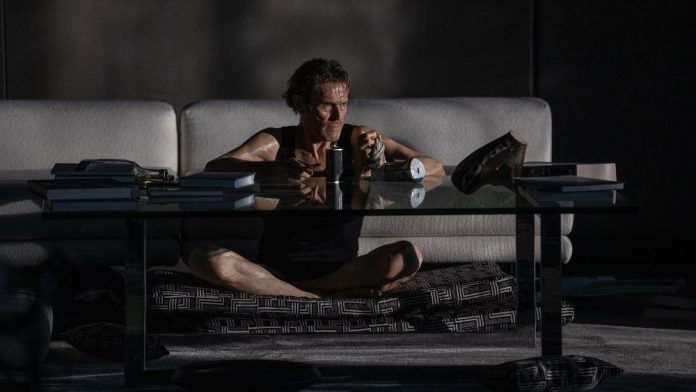Inside, which marks the English-language debut of Greek filmmaker Vasilis Katsoupis, is a beautifully-designed thriller built around an all-in performance from four-time Oscar nominee Willem Dafoe.
Dafoe plays Nemo, an art thief who finds himself trapped within a luxury penthouse apartment when the alarm is set off. Over the course of some indeterminate period of time, Nemo must figure out how to survive with very little food and water and use his environment, which includes a lot of pricey artwork, to his advantage while also trying to find a way out.
It’s an amazing film, not just because of Dafoe’s bravura turn, but due to the actual space that’s created and how it gets altered and even destroyed during Nemo’s efforts to extricate himself from his precarious situation.
Above the Line spoke with Katsoupis over Zoom a few weeks back and learned that making a movie with Dafoe in a single location involves a lot more technology than one might expect.
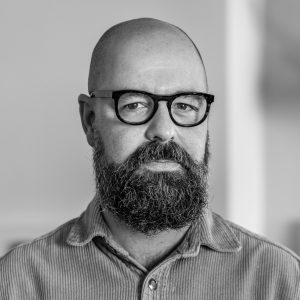
Above the Line: Your movie premiered in Berlin a few weeks back, and I’m curious to know how that went, but let’s talk about making the movie first. I read that you were inspired by a stay in New York City in a similar apartment. I’m not sure if you’ve seen a show called Open House NYC, but they do these tours of luxury penthouses that are similar to the one in which Willem Dafoe gets trapped.
Vasilis Katsoupis: I wish I knew that because I would’ve tried to [watch] or tried to make my producer see that, but it came from my visit in New York, walking around the street and [seeing] these huge skyscrapers. It came from, like, “what if someone is trapped up there?” And then, I put this [idea] of Robinson Crusoe and the castaway premise inside an apartment. I wanted to put my character in the middle of the metropolis that’s alive and buzzing around [him] and [yet he] cannot touch it [and he] cannot [communicate with] people, so then nobody can come and help him. And also, yes, I was lucky enough to stay in a certain place not [exactly] like we designed, but close enough. And, yes, the luxury feels really good, but what happens when you don’t have food and water?
ATL: How long ago did you have this idea and start writing the screenplay with Ben Hopkins?
Katsoupis: I always had it in my mind, and I categorized [it as] “a Hollywood idea.” As a Greek, Hollywood is the Mecca of film, so I had it as a “Hollywood” idea, and it was like a dream project that maybe never could be done. At one point, back in 2016, my documentary was screened at a Greek film festival in L.A. During those days, they had [a] program called Discovery Days. Basically, they select five projects that would do some workshops, and then you would pitch it to some people from the film industry. I sent them the treatment of my project, they selected it, and we went with Giorgos [Karnavas], our producer, and we pitched it. This is where we first saw there was a good reaction [to] the idea and the project.
The first thing that I wanted afterward was to find a good screenwriter because I didn’t want to write it. I strongly believe in other people’s talents and expertise [rather] than trying to force my limited talent [for] screenwriting. We got very lucky that Ben Hopkins really wanted to do that because it was very challenging [for] him. We had a good script, [and] then we took development money from [a] European media fund for the script. We got the script and then we started financing and finding co-productions with Germany and Belgium. By having Willem Dafoe on board, we then attracted more interest from financiers, and we got Focus Features involved, [so] we could make the film.
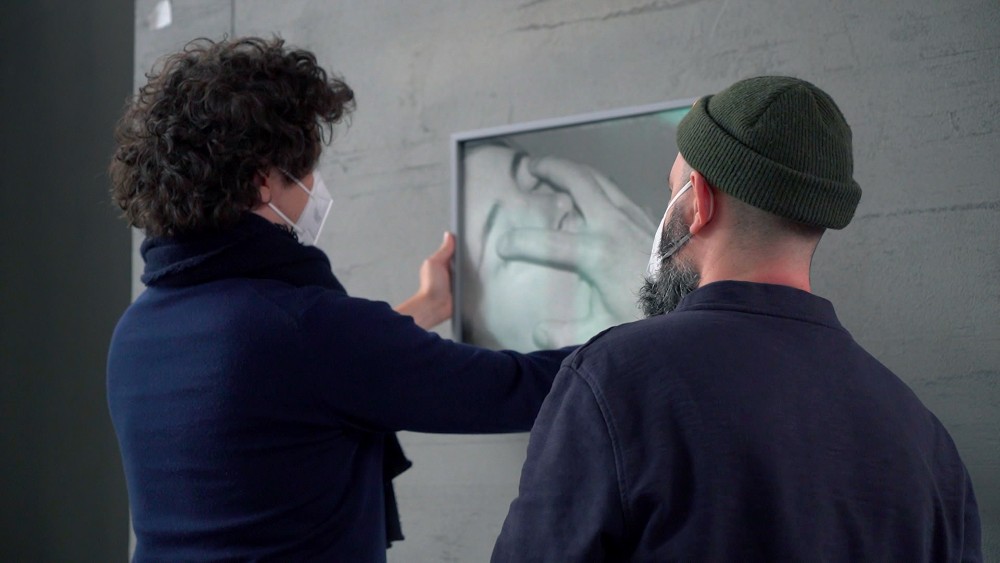
ATL: Was that workshop you mentioned only for Greek filmmakers, specifically?
Katsoupis: No, it was more for Balkan, I think. There was also a Turkish director and a Serbian director. I think we had, like, three Greek directors, one Turkish, and one Serbian director, so it was more multicultural.
ATL: I think I read that you first met Willem at a film festival as well, so did you just hand him the script, or did you go through the proper channels? Did you even mention it to him?
Katsoupis: Giorgos Karnavas found a way through another producer here in New York, and he gave the script to Willem Dafoe. At that time, he was at the Venice Film Festival, so we were expecting him to have an answer two or three weeks after the festival, or whenever he could. The good thing was his response was immediate, like the next day. He called us and said, ‘Okay, guys, I want to meet you. Let’s set a meeting in London and talk about it.’ So, that was amazing to get [that] phone call, so we met and we talked about it, and we started the film.
ATL: What kind of concerns did he have, and what did you want to make sure he knew about what was involved? Was it all there in the script, or was there stuff that you had to discuss and work out?
Katsoupis: The script was there, but what I did was, I did a presentation [for] him. My treatment, my whole research about [the] apartment, about the art collection. Also, I did a mood video that was really good. I think these elements made him understand that we were very serious, and [that] we had a project that was really loved and really well thought [out]. I guess, for him, it was a huge risk. I mean, honestly, if I was him, I wouldn’t do it [laughs]. On the other hand, I felt such a huge responsibility that sometimes I couldn’t sleep at night, but it went great. He’s such a generous and kind person. He was such a sweet guy [and] we had an amazing relationship while shooting and building this project.
ATL: It’s a good thing he did it because this is a real showcase for him, and he gives an amazing performance here. I know he’s sometimes based in Italy, so I’m curious about where you shot this. Did you shoot in Greece or in Germany?
Katsoupis: We actually shot it in Germany. It’s all in a studio; we built the set. Also, [for] the New York skyline, we filmed plates, and everything you see in the film is projection. I really wanted to construct an environment [where] he could be there and perform and [not] have his mind on anything else… [but] he felt everything. The projection was so successful that sometimes, I felt jetlagged because our biological clock was not working properly anymore — from night shoots to day shoots, and then again, night shoots. It was a really funny situation.
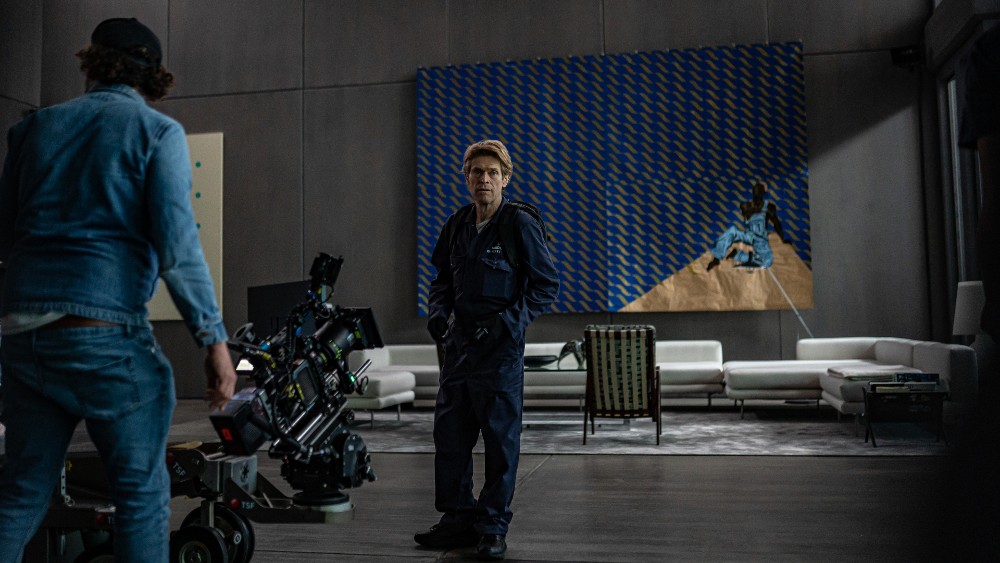
ATL: If we watch really closely, can we see the clouds moving in the background and stuff or was it just stationary backgrounds?
Katsoupis: No, it was video. We can see the lights [of] the cars passing by, very far away. It was a video projector with video footage we filmed in New York in different seasons and [at] different times of the day. It was a very interesting procedure. I took it from the film Oblivion, they filmed it [the same] way. That was where I based my whole design, but their set was smaller.
ATL: Let’s talk about the design of this set. It is one of the biggest clichés of filmmaking that the location becomes a character, but you can’t avoid that with this movie. Literally, the movie starts by showing off this gorgeous location. How did you work with your production designer, Thorsten Sabel, and were you both inspired by other places? Did you have artists involved with creating the art in the apartment?
Katsoupis: I did huge research before. I’ve seen all the photographs of the New York penthouses. The truth is that the set is based on three different houses — only one is a penthouse. The first house is by Ian Simpson, a British architect, [who] has a huge penthouse in Manchester that I found footage from. The other house [was] the [Christian] Boros house in Berlin. He’s a huge art collector [who] built his house on top of a bunker, and inside the bunker, he has his collection that you can go and visit. The third house was from Ricardo Bofill, a Spanish architect. He took a cement factory in Barcelona and he made it his house. So [it was] a combination of those.
But when Thorsten Sabel, the production designer, came on board, he took me to… I mean, I’m a big fan of brutalist architecture. He took [it] a more brutalist and minimalist way, because we started going [off] the look of these buildings by [Gottfried] Böhm, he’s one of the biggest German architects and brutalist architects. And [in] Kolkata, where we were shooting, there are many buildings and cathedrals [by] him. It was amazing because we could visit them and actually get the feeling of how the cement talks to you.
Yes, this apartment set is the co-star of the film, so it needed to be treated in a very big way. Also, the art collection is a way for showing the absent one’s personality and character — the owner’s character — so it was very detailed and constructed.
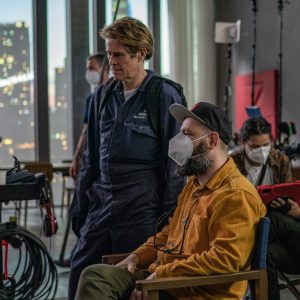
ATL: Since you were working on a single set on a stage, were you able to shoot the movie in chronological order? How did the people involved with making the art feel about the fact that a lot of it was going to be destroyed or drawn on? I know Willem is an artist as well, so I was shocked when he started painting and drawing on someone else’s artwork.
Katsoupis: He was also trained by [Julian] Schnabel for the film [At Eternity’s Gate], so he knew how to draw. We had someone to help him as well, and also, to design the murals, but funnily enough, the design of the first mural that he does, what we call “The Sun God,” the first cycle thing, was designed by Willem himself.
[It’s a] really good story, because our muralist was giving me examples of how he thought the “Sun God” would be, but that was never correct. I told that to Willem [at] a dinner that we had, and he said, ‘Okay, give me a piece of paper,’ and he started drawing, and everything he was doing while he was drawing, he gave a reason [for]. ‘It’s the cycle of life, and then you have before and after,’ and I was sold. I said, ‘Look, this is what we’re going to do.’ [chuckles] It worked, amazingly.
ATL: Very cool, and were you able to shoot chronologically, too?
Katsoupis: It’s a luxury for many films to shoot chronologically, but it was inevitable for us because that set was deteriorating day to day. That was a big danger because if we needed to reshoot something, it wouldn’t be possible. Also, I was feeding my editor [Lambis Haralambidis] all the footage that we had, so he would start doing a sample cut while we were shooting. That was a really nice procedure and [he] warned us a couple of times, especially in the beginning, that he needed some [extra] footage, so we could do a small reshoot before it was totally destroyed. But afterward, it was hit or miss. We would shoot it, and then it had to be destroyed to show that more days had passed. That also gave us the freedom to shoot so many more unscripted things and ideas and improvisations that we had while shooting that, at the end of the day, a huge percentage of the film that you see wasn’t scripted.
ATL: Did Willem just let his beard grow naturally so you could see how long he was trapped in there as you were shooting?
Katsoupis: That was one of the first things that we [discussed]. I never like prosthetic hair. They always look fake, even with the best, so we said to let it grow naturally, and your nails and everything. That was something that we said from the beginning — that we will not use prosthetic hair.
ATL: It’s been great talking to you. I’m not sure if you’ve heard about this idea of a “pandemic movie,” which is something we saw in the last few years when a filmmaker makes a movie with just one or two actors, but this story just naturally worked in that regard.
Katsoupis: Many people found themselves in a [similar] situation, but the big difference [between Inside and other movies is that in those movies,] everyone was in lockdown. That’s the biggest difference. In my film, he’s the only person that is in lockdown, so I wouldn’t consider it a “pandemic film” because it was conceived before the pandemic anyway, [though] the pandemic helped us because it was a very COVID-[friendly] production to do.
Inside is now playing in theaters nationwide courtesy of Focus Features.


